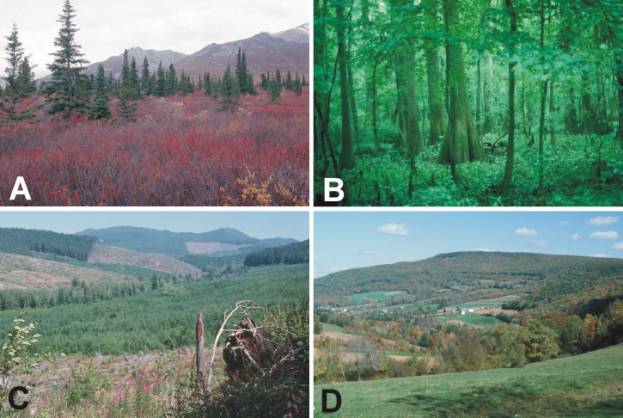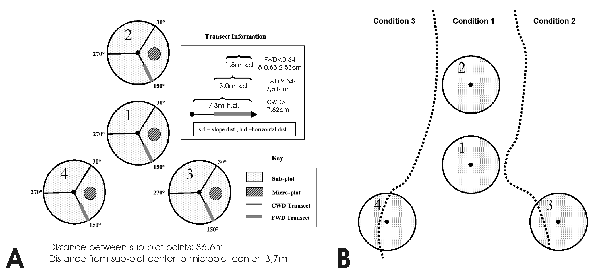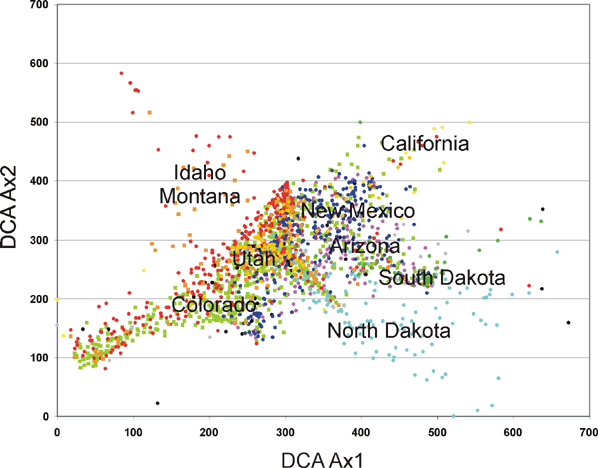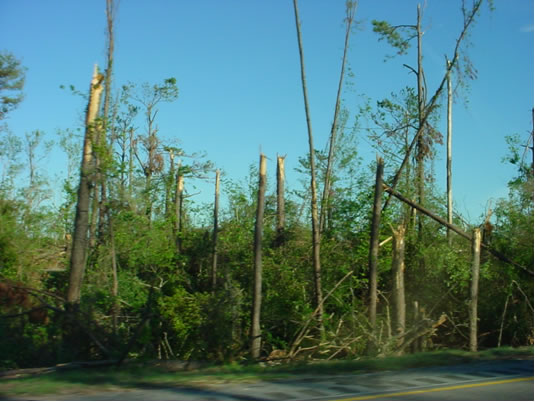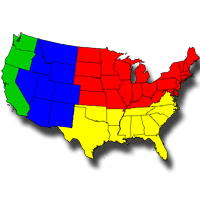
Benefits of a strategic national forest inventory to science and society: the USDA Forest Service Forest Inventory and Analysis program
iForest - Biogeosciences and Forestry, Volume 1, Issue 1, Pages 81-85 (2008)
doi: https://doi.org/10.3832/ifor0345-0010081
Published: Feb 28, 2008 - Copyright © 2008 SISEF
Commentaries & Perspectives
Abstract
Forest Inventory and Analysis, previously known as Forest Survey, is one of the oldest research and development programs in the USDA Forest Service. Statistically-based inventory efforts that started in Scandinavian countries in the 1920s raised interest in developing a similar program in the U.S. The U.S. Congress established the research branch of the U.S. Forest Service in 1928, shortly after Dr. Yrjö Ilvessalo, leader of the first Finnish national forest inventory, met with President Calvin Coolidge. Congress charged the Forest Service to find “facts as may be necessary in the determination of ways and means to balance the timber budget of the United States”. As a result, Forest Survey maintained a timber focus for much its history. As society’s interest in forests changed over time, so did information needs. Conflicts over resource allocation and use could not be resolved without up-to-date knowledge of forest status and trends. In response to society’s needs, the Forest Inventory and Analysis program has evolved from Forest Survey to address diverse topics such as forest health, carbon storage, wildlife habitat, air pollution, and invasive plants, while continuing its mandate to monitor the Nation’s timber supply. The Forest Inventory and Analysis program collects data on all land ownerships on an annual basis. The data are used to develop reports on a regular basis; reports and raw data are available to the public at no cost. The data are also used by scientists in a growing number of applications. A short history of the Forest Survey is presented with several examples of current research based on Forest Inventory and Analysis data.
Keywords
Forest Inventory, FIA, Silviculture, Disturbance, United States
Introduction
The Forest Inventory and Analysis (FIA) program, previously known as Forest Survey, is one of the oldest research and development programs in the USDA Forest Service. The program is considered the nation’s "forest census", because it includes all forest types and land ownerships in the United States. The forests are diverse both in terms of their type - ranging from boreal spruce forests in Alaska to subtropical hardwoods in Florida - and their use - including intensively managed, industry-owned forests in the Pacific Northwest and unmanaged public wilderness in the Rocky Mountains (Fig. 1). The importance of these forests, and the wide variety of forces that change them, make national strategic forest inventory a high research priority. This paper describes the history of the Forest Inventory and Analysis program, the products it produces, and the consumers of its products. Some of the research and reporting examples are specific to the Interior West FIA (IW-FIA) program, but similar examples can be found in all the regional FIA units.
Fig. 1 - Examples of forest diversity from around the United States. (A) White spruce (Picea glauca) woodland in Alaska. (B) Gum-cypress-cottonwood in South Carolina. (C) Intensively-managed Douglas-fir (Pseudotsuga menziesii) in the Oregon Cascades. (D) Oak-hickory forests in Pennsylvania.
History of the U.S. Forest Survey
Prior to the 20th century, North American forest resources were treated primarily in an extractive manner with little regard to regeneration or sustained yield. Forests were essentially mined as the wave of European settlement proceeded from east to west. In the late 19th century, as concerns about the diminishing forest resource increased and scientific forestry began to establish a foothold, interest in assessing the status and trends of the resource began to emerge. Early inventories - for example, Hough’s Report Upon Forestry ([1]) - were primarily subjective and only provided a generalized picture of forest conditions. In 1905, the Forest Service was established under the U.S. Department of Agriculture and was directed to maintain healthy and productive forest land in the U.S. Gifford Pinchot, the first director of the agency, emphasized scientific forestry based on his forestry education in Europe. In the early 1920s, Scandinavian countries started to implement statistically-based inventories, and in 1928 Dr. Yrjö Ilvessalo of the Finnish national forest inventory met with U.S. President Calvin Coolidge. Later that year, the U.S. Congress passed the McSweeney-McNary Act, establishing the research branch of USDA Forest Service, including the Forest Survey ([9]). The law specifically instructed the Forest Service:
“... to make and keep current a comprehensive survey of the present and prospective requirements for timber and other forest products in the United States, and of timber supplies, including a determination of the present and potential productivity of forest land therein, and of such other facts as may be necessary in the determination of ways and means to balance the timber budget of the United States”.
In 1929, Forest Survey planning began in Oregon and by 1932 the inventory of the western Cascades was complete. In the same year, inventories were started in Idaho, the Great Lakes States, and some southern states. During World War II there was a temporary halt to the survey. The last 3 states - Arizona, New Mexico, and Nevada - were completed in 1962, marking the end of the first inventory cycle in the coterminous 48 states. In the 1960s and 1970s, funding for the program increased; almost all states were visited again, and some twice during the period. The average re-visitation cycle between the first and second inventory was then 13-15 years. In the 1980s the Survey was active in all states except Utah and Ohio. Nationally, the re-visitation interval averaged about 12 years, but some of the southeastern states were re-inventoried as frequently as 5 or 6-year intervals ([9]).
In the late 1980s and early 1990s the program adopted a fixed periodic inventory system, with a 10-year cycle in most western states and a 5-year cycle in most southern and eastern states. However, some states, for a variety of reasons, were not re-inventoried on schedule and some states were not revisited for 15-20 years. By the early 1990s, some users of FIA data recognized that aging periodic inventories - even those done at 5-year intervals - did not meet their needs. Rapid changes, such as hurricanes and insect outbreaks, prematurely outdated periodic inventory data. As a result, the U.S. Congress included language in the 1998 Farm Bill requiring the FIA program to convert to a continuous annual inventory system and produce state-level results on a regular schedule.
Today, the FIA program operates 4 regional programs (Fig. 2) and conducts inventory on over 3 million forested hectares in the United States and U.S. Territories. Nearly all states have been converted to the annual inventory system using a standardized plot design (see below). Funding for the program has increased dramatically since 1998. Following passage of the 1998 Farm Bill, FIA program managers were asked to provide an estimate of the cost to implement the annual inventory in every state. While the required amount has not yet been appropriated, the gap between program needs and actual funding as decreased over the years. It should be noted that approximately 15% of the FIA budget is used for quality control of methods and data.
Fig. 2 - Regional Forest and Inventory and Analysis units and approximate forested area included in each.
How it is done
FIA inventories are conducted using a double sampling design, with plots arranged on a systematic grid. It is sometimes referred to as a 3-phase design, although this is not a precise description of the statistical design. The third “phase”, described below, actually consists of additional variables that are measured on a subset of plots. The term “phase” is commonly used to refer to plot type and will also be used here. Phase 1 (P1) plots are based on remotely sensed data and are used for stratification. In the past, Phase 1 consisted of airphoto points located on a 1-kilometer grid, but the availability of satellite imagery now allows for continuous (wall-to-wall) stratification. Phase 1 points are used to determine expansion factors for strata (e.g., forest nonforest) at geographic scales smaller than states (e.g., counties or sample zones). Therefore, forest area represented by a Phase 2 plot is determined according to stratification of Phase 1 plots and not strictly by their grid spacing.
Phase 2 (P2) plots, also known as standard FIA plots, are located at 5-kilometer intervals, equal to an intensity of approximately 1 field plot per 2388 hectares. The P2 plot design consists of 4 subplots of 0.017 ha each, with centers 36.6 m apart (Fig. 3A). Plots are mapped when more than one forest or non-forest condition occurs (Fig. 3B). Up to 120 variables are recorded at the plot, subplot, condition, or tree level. Under the annual inventory system, a fraction of the plots on the P2 grid (10% in the west and 15% in the east) are measured each year. Plots belonging to an annual panel are distributed across each state so as to be free of geographical bias.
Fig. 3 - FIA plot design (A) and example of mapping several conditions on one plot (B). FWD = fine woody debris and CWD = coarse woody debris. Woody debris diameter ranges are listed with the portion of the transect on which the classes are recorded.
Phase 3 (P3) plots, also known as Forest Health Monitoring plots, are a subset of P2 plots, with 1 field plot per approximately 38 850 ha (16x the area represented by a P2 plot). On P3 plots, several “health indicators” are measured woody material, soils, lichens, crown conditions, and ozone as well as all P2 variables. P3 plots were remeasured on a 5-year cycle, but recently have been synchronized to the local P2 cycle.
Use of FIA Data by Science and Society
FIA data are used by many sectors of society, each of which prefers data or analyses in different formats. The distinction in the title of this paper between science and society the former of which is obviously a subset of the latter is based on both data needs and the extent to which in each group has historically used FIA data. Basic FIA products, such as State or National Forest inventory reports are used by a wide variety of clients for information and planning purposes. FIA also produces special reports on topics such as forest health or timber products output. In addition to hardcopy format, these reports are accessible to the public on the worldwide web at no cost.
If a user needs more data and tables than are presented in FIA reports, he or she can produce customized tables or download raw data using the Forest Inventory Mapmaker web interface (⇒ http://www.ncrs2.fs.fed.us/4801/FIADB/index.htm). Data may be summarized at the state and county level, by user-defined latitude-longitude boundaries, or within a circle of user-defined center and radius. Output may be obtained in the form of a standard table set, user-defined tables, maps, or dump files ready for input in the Forest Vegetation Simulator ([2], [10]). If these products do not meet the user’s needs, raw data are available as database tables in comma-delimited format, organized by state and inventory year. Under the annual inventory system, data are usually available to the public within 6 months of the time that the last plots have been measured in a state.
In response to user demand in recent years, the FIA program has devoted significant resources to the development of map products and mapping techniques. These products are produced by combining FIA data with a wide variety of GIS data (usually at 250m to 1km resolution), using multivariate analysis methods.
Examples of Scientific Applications Using FIA Data
FIA scientists have long used FIA data as a research data set, and have implemented many studies designed to improve inventory and monitoring techniques. In addition, FIA scientists frequently collaborate with scientists at universities and other government agencies on a variety of studies. Over 1425 citations related to the FIA program were published from 1976 to 2001, including over 50 master’s theses and 100 doctoral dissertations ([4]). The range of topics includes air pollution, biomass and dead wood, esthetics, nonforest influences, owner attitudes, rangeland values, recreation opportunities, water quality, vegetative habitat typing, and wildlife habitat. The number and scope of papers has increased steadily over the past 30 years ([4]).
Recent examples of silvicultural and ecological research in the Interior West include development of density management diagrams ([3]), range-wide analysis of aspen stand structure ([5]), and monitoring the effects of prolonged drought on pinyon-juniper woodlands ([6]). One important factor, common to these and other FIA based studies, is that the data are drawn from an unbiased, systematic sample of plots that are distributed throughout the range of the forest types of interest.
The ponderosa pine density management diagram ([3]) was developed using 767 plots selected from over 8800 FIA plots on which ponderosa pine occurred. Analysis plots were selected according to strict composition and structural criteria, and represented the entire range of ponderosa pine in the U.S. Maximal stand density was found to be similar among regions, but there were regional differences in "typical" stand structure and composition. As a result, it was shown that the diagram would be applicable throughout the range of ponderosa pine in the U.S.
In the aspen study ([5]), 3371 plots from 19 FIA surveys in 13 states in the western U.S. were found to have at least one aspen present. There were 70 associated tree species, and 45 of those were sufficiently common as to be included in the analysis. Ordination of stands based on structure and composition revealed broad regional patterns (Fig. 4). These patterns may be used to develop strategies for regional risk assessment, because structural and compositional characteristics offer insight into possible successional patterns and potential responses to disturbance.
Fig. 4 - DCA plot of aspen structure and composition in the western United States. Labels are at approximate DCA coordinates for geographic regions (from [5]).
Assessment of drought effects in pinyon-juniper woodlands was possible because implementation of the annual inventory system was coincident with the beginning of the drought in the American Southwest ([6]). Recent periodic inventories and the first 2 years of annual inventory showed that, in non-drought years, background mortality of pinyon and juniper species was relatively low. Mortality increased dramatically over a 2-year period, before wetter weather and crashing beetle populations caused mortality rates to decrease. The availability of annual inventory data made it possible to track the progression of mortality in "real time". The current estimate is that approximately 6% of the basal area of pinyon died due to drought-related causes since 2000, with Arizona suffering the greatest amount of pinyon mortality (>13% of basal area) and Nevada having the lowest pinyon mortality (3% of basal area - Fig. 5). No estimate will be available for New Mexico until annual inventory is implemented, but mortality models, based on edaphic factors and stand structural characteristics of affected plots in other states, should permit predictions of severity and extent.
Fig. 5 - Progression of pinyon mortality (% of basal area) 2000-2004, based on FIA annual inventory data from 4 western states (from [6]); AZ = Arizona, CO = Colorado, NV = Nevada, UT = Utah, All = entire 4-state area.
A common and important aspect of these studies is that the results were obtained using data available to the public in other words, the results can be produced (or reproduced) by anyone. Although verifiability is an important tenet of scientific inquiry, access to researchers’ data can be difficult at times. However, data collected under the FIA program, which is publicly funded, are available to all. This fact in itself constitutes an important contribution to science and society. That being said, there are also safeguards in place to ensure confidentiality of data collected on private lands and the integrity of permanent plot locations. This (perhaps unique) combination of openness and security contribute to users’ confidence in the integrity of the FIA program.
Continuing Value of FIA
The discussion above of mortality in pinyon-juniper woodlands alluded to the value of continuous inventory under the annual system. However, recent events in particular, the devastating effects of hurricanes Katrina and Rita on the southeastern U.S. (Fig. 6) may further prove the value of the FIA program. At the time of this presentation (September 27, 2005), only 29 days after Katrina made landfall, the FIA program has produced a rapid assessment of the economic and ecological damage caused by the hurricane ([7], [8]):
Fig. 6 - Forest damage typical of areas severely affected by hurricanes Katrina and Rita. Dominant species on this site was loblolly pine (Pinus taeda).
- Over 2.000.000 ha of forest were affected by Katrina
- The value of timber affected is greater than $US 5.000.000.000
- If recoverable, damaged wood is sufficient to produce 800.000 single family homes and 20.000.000.000 kilos of paper products
- Most of the damage occurred within 95km of the Gulf Coast
- Approximately 2/3 of the damage occurred in Mississippi
- Detailed FIA assessment has already started, and the inventory will be updated annually as annual panels are completed
It should be noted that continuing assessment of hurricane damage will not require a change in FIA sampling protocol, although grid intensification or other ad-hoc changes may be made to answer specific questions. The annual inventory system, conducted on a routine basis, will permit not only assessment of hurricane damage, but also the effects of salvage, insect outbreaks, and fire in the affected areas, as well as monitoring recovery over time.
Conclusions
The USDA Forest Service Forest Inventory and Analysis program serves a broad segment of society by keeping a comprehensive inventory of the forests of the U.S., and producing data, summaries, and analyses for a variety of audiences. Use of FIA data has been growing steadily over the past 3 decades, but use in scientific applications is still lower than potential. However, the list of research applications is growing as more scientists become familiar with the program. Open access to data, the integrity of the program, and continuing service to society has earned support that is important in a time of tight budgets. Finally, the recent evolution of the FIA program into a continuous annual inventory system ensures that FIA data will only become increasingly valuable with time.
References
Gscholar
Gscholar
Online | Gscholar
Gscholar
Gscholar
Gscholar
Gscholar
Authors’ Info
Authors’ Affiliation
USDA Forest Service, Rocky Mountain Research Station - 507 25th Street, Ogden, Utah (USA)
Corresponding author
Paper Info
Citation
Shaw JD (2008). Benefits of a strategic national forest inventory to science and society: the USDA Forest Service Forest Inventory and Analysis program. iForest 1: 81-85. - doi: 10.3832/ifor0345-0010081
Paper history
Received: Dec 29, 2005
Accepted: Feb 07, 2006
First online: Feb 28, 2008
Publication Date: Feb 28, 2008
Publication Time: 25.03 months
Copyright Information
© SISEF - The Italian Society of Silviculture and Forest Ecology 2008
Open Access
This article is distributed under the terms of the Creative Commons Attribution-Non Commercial 4.0 International (https://creativecommons.org/licenses/by-nc/4.0/), which permits unrestricted use, distribution, and reproduction in any medium, provided you give appropriate credit to the original author(s) and the source, provide a link to the Creative Commons license, and indicate if changes were made.
Web Metrics
Breakdown by View Type
Article Usage
Total Article Views: 60520
(from publication date up to now)
Breakdown by View Type
HTML Page Views: 49259
Abstract Page Views: 3602
PDF Downloads: 6335
Citation/Reference Downloads: 75
XML Downloads: 1249
Web Metrics
Days since publication: 6486
Overall contacts: 60520
Avg. contacts per week: 65.32
Article Citations
Article citations are based on data periodically collected from the Clarivate Web of Science web site
(last update: Mar 2025)
Total number of cites (since 2008): 7
Average cites per year: 0.39
Publication Metrics
by Dimensions ©
Articles citing this article
List of the papers citing this article based on CrossRef Cited-by.
Related Contents
iForest Similar Articles
Review Papers
Opportunities for coppice management at the landscape level: the Italian experience
vol. 9, pp. 775-782 (online: 04 August 2016)
Research Articles
Stem profile of red oaks in a bottomland hardwood restoration plantation forest in the Arkansas Delta (USA)
vol. 15, pp. 179-186 (online: 19 May 2022)
Research Articles
Amount and distribution of coarse woody debris in pine ecosystems of north-western Spain, Russia and the United States
vol. 7, pp. 53-60 (online: 28 October 2013)
Research Articles
Tree-oriented silviculture: a new approach for coppice stands
vol. 9, pp. 791-800 (online: 04 August 2016)
Review Papers
Integration of forest mapping and inventory to support forest management
vol. 3, pp. 59-64 (online: 17 May 2010)
Review Papers
Should the silviculture of Aleppo pine (Pinus halepensis Mill.) stands in northern Africa be oriented towards wood or seed and cone production? Diagnosis and current potentiality
vol. 12, pp. 297-305 (online: 27 May 2019)
Review Papers
Structure and management of beech (Fagus sylvatica L.) forests in Italy
vol. 2, pp. 105-113 (online: 10 June 2009)
Research Articles
Disassociating tree species associations in the eastern United States
vol. 7, pp. 248-254 (online: 13 March 2014)
Research Articles
Evaluation of urban forest landscape health: a case study of the Nanguo Peach Garden, China
vol. 13, pp. 175-184 (online: 02 May 2020)
Short Communications
The Polish landscape changing due to forest policy and forest management
vol. 2, pp. 140-142 (online: 30 July 2009)
iForest Database Search
Search By Author
Search By Keyword
Google Scholar Search
Citing Articles
Search By Author
Search By Keywords
PubMed Search
Search By Author
Search By Keyword

